
The southern platyfish, common platy, or moonfish is a species of freshwater fish in family Poeciliidae of order Cyprinodontiformes. A live-bearer, it is closely related to the green swordtail and can interbreed with it. It is native to an area of North and Central America stretching from Veracruz, Mexico, to northern Belize.

Cichlids are fish from the family Cichlidae in the order Cichliformes. Traditionally Cichlids were classed in a suborder, the Labroidei, along with the wrasses (Labridae), in the order Perciformes, but molecular studies have contradicted this grouping. On the basis of fossil evidence, it first appeared in Argentina during the Early Eocene epoch, about 48.6 million years ago; however, molecular clock estimates have placed the family's origin as far back as 67 million years ago, during the late Cretaceous period. The closest living relative of cichlids is probably the convict blenny, and both families are classified in the 5th edition of Fishes of the World as the two families in the Cichliformes, part of the subseries Ovalentaria. This family is large, diverse, and widely dispersed. At least 1,650 species have been scientifically described, making it one of the largest vertebrate families. New species are discovered annually, and many species remain undescribed. The actual number of species is therefore unknown, with estimates varying between 2,000 and 3,000.
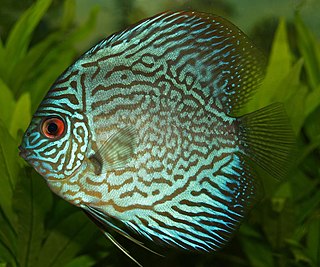
Symphysodon is a genus of cichlids native to the Amazon river basin in Brazil. Due to their distinctive shape, calm behavior, many bright colors and patterns, and dedicated parenting techniques, discus are popular as freshwater aquarium fish, and their aquaculture in several countries in Asia is a major industry. They are sometimes referred to as pompadour fish. The discus fish has attracted a cult following of collectors and has created a multimillion dollar international industry complete with shows, competitions, and reputable online breeders.

The neon tetra is a freshwater fish of the characin family of order Characiformes. The type species of its genus, it is native to blackwater and clearwater streams in the Amazon basin of South America. Its bright colouring makes the fish visible to conspecifics in the dark blackwater streams, and is also the main reason for its popularity among freshwater fish hobbyists, with neon tetras being one of the most widely kept tropical fish in the world.
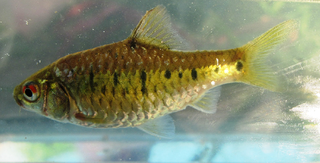
Barbodes semifasciolatus, the Chinese barb, is a species of cyprinid fish native to the Red River basin in southeast Asia where they occur in fresh waters at depths of 5 metres (16 ft) or less. The captive variant popularly known as the gold barb or Schuberti barb is an extremely popular aquarium fish.

The green terror is a colorful freshwater fish in the cichlid family. The fish originates from the Pacific side of South America from the Tumbes River in Peru to the Esmeraldas River in Ecuador. It is polymorphic and can have white or gold-orange edging to the tail and dorsal fins. It has historically been confused with two other species that always have narrow, clearly defined white edging, the more southerly distributed A. stalsbergi and the more northerly A. blombergi.

Tropical fish are fish found in aquatic tropical environments around the world. Fishkeepers often keep tropical fish in freshwater and saltwater aquariums. The term "tropical fish" is not a taxonomic group, but rather is a general term for fish found in such environments, particularly those kept in aquariums.
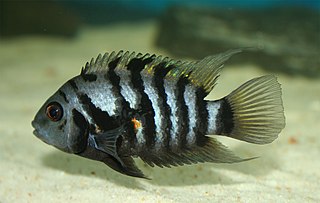
The convict cichlid is a fish species from the family Cichlidae, native to Central America, also known as the zebra cichlid. Convict cichlids are popular aquarium fish and have also been the subject of numerous studies on fish behaviour.

Fishkeeping is a popular hobby, practiced by aquarists, concerned with keeping fish in a home aquarium or garden pond. It is a practice that encompasses the art of maintaining one's own aquatic ecosystem, featuring a lot of variety with various water systems, all of which have their own unique features and requirements. Fishkeeping primarily serves as a token of appreciation and fascination for marine life and the environment that surrounds such, along with other purposes such as the piscicultural fishkeeping industry, serving as a branch of agriculture, being one of the most widespread methods of cultivating fish for commercial profit.

The ram cichlid is a species of freshwater fish endemic to the Orinoco River basin, in the savannahs of Venezuela and Colombia in South America. The species has been examined in studies on fish behaviour and is a popular aquarium fish, traded under a variety of common names, including ram, blue ram, German blue ram, Asian ram, butterfly cichlid, Ramirez's dwarf cichlid, dwarf butterfly cichlid and Ramirezi. The species is a member of the family Cichlidae and subfamily Geophaginae.
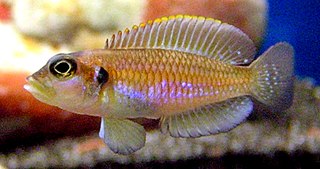
Lamprologus ocellatus is a species of shell dwelling cichlid endemic to Lake Tanganyika. It is a popular aquarium fish due to its small size, appearance, and intelligence.
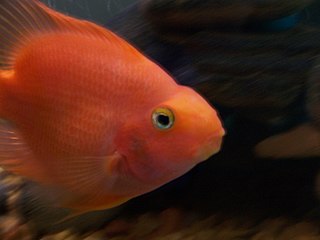
The Blood Parrot Cichlid , or parrotcichlid, is a hybrid species of fish in the family Cichlidae. The fish was first bred in Taiwan around 1986. Blood parrots should not be confused with other parrot cichlids or salt water parrotfish. Natural colors of the fish are red, yellow, and grey: other colors are injected by breeders.

Pelvicachromis pulcher is a freshwater fish of the cichlid family, endemic to Nigeria and Cameroon. It is popular amongst aquarium hobbyists, and is most commonly sold under the name kribensis, although it has other common names, including various derivatives and color morphs of the kribensis: krib, common krib, red krib, super-red krib and rainbow krib, along with rainbow cichlid and purple cichlid.
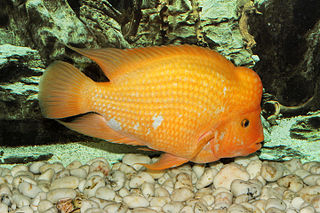
Amphilophus citrinellus is a large cichlid fish endemic to the San Juan River and adjacent watersheds in Costa Rica and Nicaragua. In the aquarium trade A. citrinellus is often sold under the trade name of Midas cichlid. A. citrinellus are omnivorous and their diet consists of plant material, molluscs and smaller fish. The species is closely related to, but not to be mistaken for, Amphilophus labiatus, which shares the nickname red devil cichlid.

The Texas cichlid, also known as the Rio Grande cichlid, is a freshwater fish of the cichlid family, and the only cichlid species that is native to the United States. It is found in the lower Rio Grande drainage in Texas near Brownsville and northeastern Mexico.
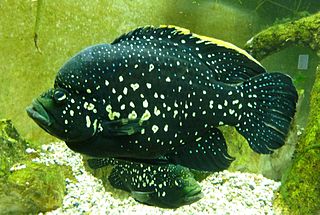
Paratilapia polleni is a medium-sized cichlid endemic to Madagascar. It is also a popular fish for display at public aquaria.
The three spot cichlid, also known as the trimac or red-eyed cichlid, is a species of cichlid from Mexico and Central America, from the subfamily Cichlasomatinae. It is rarely found as an aquarium fish. Although still included as a highly aberrant member of Cichlasoma by FishBase, other authorities such as Catalog of Fishes have moved it to the genus Amphilophus.

Apistogramma hongsloi is a species of dwarf cichlid fish, native to the Orinoco basin in South America. They are often kept in the aquariums and prefer to have soft, acidic water.

Nuptial tubercles or breeding tubercles are noticeable skin roughness or horny nodules that form on male fish during breeding. They are made of keratin, the same material as hair, hooves, and fingernails.
Vieja bifasciata, also known as the twoband cichlid or red-spotted cichlid, is a large and colorful freshwater fish native to Mexico and Guatemala. It is found from the River Grijalva and Usumacinta basins in western parts of Mexico and Guatemala. It belongs to the family Cichlidae, which includes many popular aquarium fish. Vieja bifasciata can grow up to 12 inches in length and has a deep-bodied shape. It has a reddish-brown base color with two black bands running along the body, and a red or yellow patch on the forehead. The fins are also edged with different colors, and the tail fin is slightly forked.






















